
Acacia acanthoclada, commonly known as harrow wattle, is a species of flowering plant in the family Fabaceae and is endemic to southern continental Australia. It is a low, highly branched, spreading and spiny shrub with wedge-shaped to triangular or egg-shaped phyllodes with the narrower end towards the base, and spherical heads of up to 30 flowers, and linear, spirally-coiled pods.

Acacia alata, commonly known as winged wattle, is a species of flowering plant in the family Fabaceae and is endemic to the south-west of Western Australia. It is a much-branched shrub, its phyllodes continuous with the branches and arranged on either side of them, flowers arranged in racemes of 2 spherical heads of white to golden-yellow flowers, and flat, curved, crusty pods 20–80 mm (0.79–3.15 in) long.

Acacia brunioides, commonly known as brown wattle is a species of flowering plant in the family Fabaceae and is endemic to eastern Australia. It is an erect or spreading shrub with more or less cylindrical phyllodes, inflorescenses arranged singly in leaf axils, each with 20 to 27 more or less white to bright yellow flowers, and straight, papery to leathery pods up to 15–60 mm (0.59–2.36 in) long.

Acacia aemula is a species of flowering plant in the family Fabaceae and is endemic to the south coast of Western Australia. It is an openly-branched, often prostrate, rush-like subshrub with cylindrical to more or less flat and linear phyllodes similar to its branchlets, spherical heads of cream-coloured or golden-yellow flowers and reddish-brown, thin, paper-like or crusty pods.
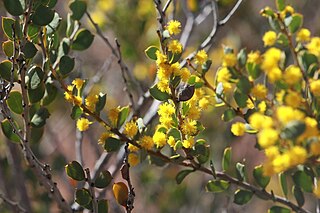
Acacia acoma is a species of flowering plant in the family Fabaceae and is endemic to inland ares of south-western Western Australia. It is an erect, spindly, open or spreading shrub with variably-shaped, often narrowly oblong phyllodes, flowers arranged in spherical heads, usually arranged in pairs in leaf axils, and strongly curved or spirally coiled pods up to 15 mm (0.59 in) long when expanded.

Acacia aculeiformis is a species of flowering plant in the family Fabaceae and is endemic to the south-west of Western Australia. It is prostrate, scrambling, mat-forming shrub with asymmetrical elliptic to narrowly elliptic phyllodes, and spherical heads of light to medium golden-yellow or yellowish-red flowers.
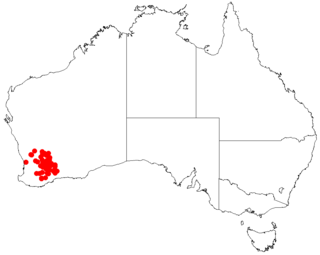
Acacia acutata is a species of flowering plant in the family Fabaceae and is endemic to the south-west of Western Australia. It is an inticately branched, often compact shrub with spiny branchlets, sharply pointed, triangular to trowel-shaped phyllodes, flowers arranged in spherical heads of 11 to 15 flowers, and firmly papery pods, rounded over the seeds.

Acacia adinophylla is a species of flowering plant in the family Fabaceae and is endemic to a small area in the south-west of Western Australia. It is a prostrate to erect, scrambling shrub with cylindrical branchlets, narrowly wedge-shaped to lance-shaped phyllodes, flowers arranged in up to 4 spherical heads of dull golden yellow flowers, and paper-like pods.
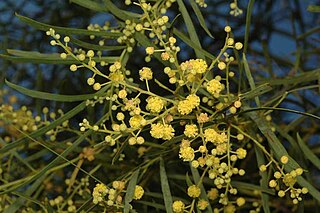
Acacia aestivalis is a species of flowering plant in the family Fabaceae and is endemic to the south-west of Western Australia. It is a bushy shrub or tree with linear to narrowly lance-shaped phyllodes, the narrower end towards the base, racemes of 5 to 11 spherical heads of golden-yellow flowers, and glabrous, papery to thinly leathery pods.
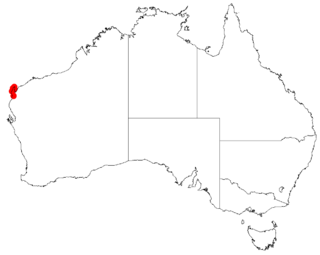
Acacia alexandri is a species of flowering plant in the family Fabaceae and is endemic to the Cape Range in the north-west of Western Australia. It is a glabrous shrub with slender branchlets, linear phyllodes, and cream-coloured flowers arranged in 1 or 2 spherical heads in the axils of phyllodes, and narrowly oblong, papery pods up to 70 mm (2.8 in) long.

Acacia amblygona, commonly known as fan wattle or fan leaf wattle, is a species of flowering plant in the family Fabaceae and is endemic to continental Australia. It is a sprawling, sometimes prostrate shrub with sharply-pointed, lance-shaped, tapering phyllodes, golden-yellow flowers arranged in a spherical head of 10 to 18 in the axils of phyllodes, and curved, coiled or twisted pods up to 70 mm (2.8 in) long.

Acacia ryaniana is a shrub of the genus Acacia and the subgenus Phyllodineae that is endemic to an area along the west coast of Australia.

Acacia adenogonia is a species of flowering plant in the family Fabaceae and is endemic to northern Western Australia. It is a prickly, erect to sprawling shrub with cylindrical branchlets, egg-shaped to lance-shaped phyllodes, flowers arranged in spherical heads of golden yellow flowers, and thin leathery pods that are constricted between the seeds.
Acacia adnata is a species of flowering plant in the family Fabaceae and is endemic to a small area in the south-west of Western Australia. It is a shrub with sessile, oblong, sharply pointed phyllodes, and leathery, linear pods. The flowers are unknown.

Acacia veronica, commonly known as Veronica's wattle, is a shrub or tree of the genus Acacia and the subgenus Plurinerves that is endemic to a small area of south western Australia.

Acacia alcockii, also known as Alcock's wattle, is a species of flowering plant in the family Fabaceae and is endemic to South Australia. It is a bushy shrub with narrowly elliptic to lance-shaped phyllodes with the narrower end towards the base, and racemes of 5 to 11 spherical heads of pale yellow flowers, and oblong pods.

Acacia cretacea, also known as chalky wattle, is a shrub belonging to the genus Acacia and the subgenus Phyllodineae that is endemic to South Australia.

Acacia simmonsiana, commonly known as Simmons wattle or desert manna wattle, is a shrub belonging to the genus Acacia and the subgenus Phyllodineae native to south eastern Australia.
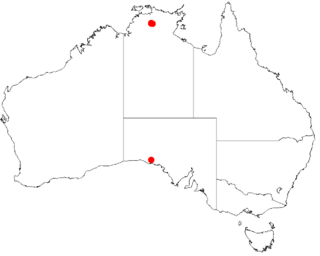
Acacia amanda is a species of flowering plant in the family Fabaceae and is endemic to a very restricted part of the Northern Territory. It is an erect shrub with narrowly elliptic or elliptic, leathery phyllodes, flowers arranged spherical heads of golden yellow flowers usually arranged in a raceme, and narrowly oblong pods 42–110 mm (1.7–4.3 in) long.
Acacia adjutrices, commonly known as convivial wattle, is a species of flowering plant in the family Fabaceae and is endemic to a few places in the south-west of Western Australia. It is a small, multi-stemmed shrub with thin stems, mostly linear, ascending to erect phyllodes, flowers arranged in up to 4 spherical heads of golden yellow flowers, and crust-like, linear to narrowly oblong pods.



















